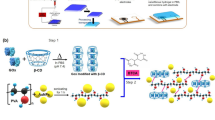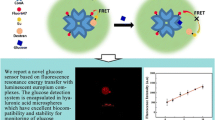Abstract
Diabetes mellitus is a chronic metabolic disorder, requiring vigilant monitoring of blood glucose levels. In this study, an injectable fluorescent enzymatic hydrogel was designed for rapid glucose detection. The leakage-free glucose-responsive hydrogel was constructed by the covalent linkage of a multi-arm poly-(ethylene glycol) (PEG), bovine serum albumin (BSA), glucose oxidase (GOx), and 4-(aminomethyl)-6,7-dimethoxycoumarin (Coumarin-NH2). The GOx serves as glucose-recognition element and the pH-sensitive Coumarin-NH2 as a fluorescence turn-on reporter. The material properties of the fluorescent hydrogel were systematically characterized which show high elasticity with good mechanical strength. Upon the addition of glucose, the as-developed fluorescent hydrogel shows a fast response time, good sensitivity, and good reproducibility at physiological pH and ambient temperature. The glucose-sensing mechanism is based on the oxidation of the glucose by GOx that generates protons to change the local pH. Consequently, protonation of the covalently immobilized and pH-sensitive Coumarin-NH2 turns on the fluorescence of the coumarin. The fluorescence hydrogel developed holds great promise as an injectable, implantable glucose-sensing biomaterials for in vivo continuous glucose monitoring.






Similar content being viewed by others
Reference
Control, D., & Trial, C. (2005). Intensive diabetes treatment and cardiovascular disease in patients with type 1 diabetes. The New England Journal of Medicine, 353, 2643.
Shamoon, H., Duffy, H., Fleischer, N., Engel, S., Saenger, P., Strelzyn, M., Litwak, M., Wylierosett, J., Farkash, A., & Geiger, D. (1993). The effect of intensive treatment of diabetes on the development and progression of long-term complications in insulin-dependent diabetes mellitus. New England Journal of Medicine, 329, 977–986.
Reach, G., & Wilson, G. S. (1992). Can continuous glucose monitoring be used for the treatment of diabetes? Analytical Chemistry, 64, 381A–386A.
Sun, X., Stagon, S., Huang, H., Chen, J., & Lei, Y. (2014). Functionalized aligned silver nanorod arrays for glucose sensing through surface enhanced Raman scattering. RSC Advances, 4, 23382–23388.
Newman, J. D., & Turner, A. P. (2005). Home blood glucose biosensors: a commercial perspective. Biosensors and Bioelectronics, 20, 2435–2453.
Klonoff, D. C. (2005). Continuous glucose monitoring roadmap for 21st century diabetes therapy. Diabetes Care, 28, 1231–1239.
Pickup, J. C., Hussain, F., Evans, N. D., Rolinski, O. J., & Birch, D. J. (2005). Fluorescence-based glucose sensors. Biosensors and Bioelectronics, 20, 2555–2565.
Chan, W. C., Maxwell, D. J., Gao, X., Bailey, R. E., Han, M., & Nie, S. (2002). Luminescent quantum dots for multiplexed biological detection and imaging. Current Opinion in Biotechnology, 13, 40–46.
Clapp, A. R., Medintz, I. L., Mauro, J. M., Fisher, B. R., Bawendi, M. G., & Mattoussi, H. (2004). Fluorescence resonance energy transfer between quantum dot donors and dye-labeled protein acceptors. Journal of the American Chemical Society, 126, 301–310.
Mopidevi, S., Chen, J., Ma, X., Galil, K. H. A. E. and Lei, Y. (2015) PEG-fluorescein-GOx hydrogel for glucose biosensing. ScienceJet, 4. Article # 159.
Odaci, D., Gacal, B. N., Gacal, B., Timur, S., & Yagci, Y. (2009). Fluorescence sensing of glucose using glucose oxidase modified by PVA-pyrene prepared via “click” chemistry. Biomacromolecules, 10, 2928–2934.
Vaddiraju, S., Burgess, D. J., Tomazos, I., Jain, F. C., & Papadimitrakopoulos, F. (2010). Technologies for continuous glucose monitoring: current problems and future promises. Journal of Diabetes Science and Technology, 4, 1540–1562.
Gerlach, G., & Arndt, K.-F. (2009). Hydrogel sensors and actuators: engineering and technology. Springer Science & Business Media.
Lim, N. C., Pavlova, S. V., & Brückner, C. (2008). Squaramide hydroxamate-based chemidosimeter responding to iron (III) with a fluorescence intensity increase. Inorganic Chemistry, 48, 1173–1182.
Peng, H. T., Blostein, M. D., & Shek, P. N. (2009). Experimental optimization of an in situ forming hydrogel for hemorrhage control. Journal of Biomedical Materials Research Part B: Applied Biomaterials, 89, 199–209.
Mossavarali, S., Hosseinkhani, S., Ranjbar, B., & Miroliaei, M. (2006). Stepwise modification of lysine residues of glucose oxidase with citraconic anhydride. International Journal of Biological Macromolecules, 39, 192–196.
Li, L., Ge, J., Guo, B., & Ma, P. X. (2014). In situ forming biodegradable electroactive hydrogels. Polymer Chemistry, 5, 2880–2890.
Dinu, M. V., Ozmen, M. M., Dragan, E. S., & Okay, O. (2007). Freezing as a path to build macroporous structures: superfast responsive polyacrylamide hydrogels. Polymer, 48, 195–204.
Chao, G., Deng, H., Huang, Q., Jia, W., Huang, W., Gu, Y., Tan, H., Fan, L., Liu, C., & Huang, A. (2006). Preparation and characterization of pH sensitive semi-interpenetrating network hydrogel based on methacrylic acid, bovine serum albumin (BSA), and PEG. Journal of Polymer Research, 13, 349–355.
Kiskan, B., & Yagci, Y. (2007). Thermally curable benzoxazine monomer with a photodimerizable coumarin group. Journal of Polymer Science Part A: Polymer Chemistry, 45, 1670–1676.
Brøndsted, H. and Kopec̆ek, J. i. (1991) Hydrogels for site-specific oral drug delivery: synthesis and characterization. Biomaterials, 12, 584–592.
Bryant, S. J., Arthur, J. A., & Anseth, K. S. (2005). Incorporation of tissue-specific molecules alters chondrocyte metabolism and gene expression in photocrosslinked hydrogels. Acta Biomaterialia, 1, 243–252.
Chivukula, P., Dušek, K., Wang, D., Dušková-Smrčková, M., Kopečková, P., & Kopeček, J. (2006). Synthesis and characterization of novel aromatic azo bond-containing pH-sensitive and hydrolytically cleavable IPN hydrogels. Biomaterials, 27, 1140–1151.
Coviello, T., Alhaique, F., Parisi, C., Matricardi, P., Bocchinfuso, G., & Grassi, M. (2005). A new polysaccharidic gel matrix for drug delivery: preparation and mechanical properties. Journal of Controlled Release, 102, 643–656.
Drury, J. L., Dennis, R. G., & Mooney, D. J. (2004). The tensile properties of alginate hydrogels. Biomaterials, 25, 3187–3199.
Zhang, X.-Z., Lewis, P. J., & Chu, C.-C. (2005). Fabrication and characterization of a smart drug delivery system: microsphere in hydrogel. Biomaterials, 26, 3299–3309.
Gayet, J.-C., He, P., & Fortier, G. (1998). Bioartificial polymeric material: poly (ethylene glycol) crosslinked with albumin. II: mechanical and thermal properties. Journal of Bioactive and Compatible Polymers, 13, 179–197.
Gulrez, S. K., Phillips, G. O., & Al-Assaf, S. (2011). Hydrogels: methods of preparation, characterisation and (applications. ed., ). INTECH Open Access Publisher.
Peppas, N. A., & Barr-Howell, B. D. (1986). Characterization of the crosslinked structure of hydrogels. Hydrogels in Medicine and Pharmacy, 1, 27–56.
Heo, Y. J., Shibata, H., Okitsu, T., Kawanishi, T. and Takeuchi, S. (2011) Long-term in vivo glucose monitoring using fluorescent hydrogel fibers. Proceedings of the National Academy of Sciences, 108, 13399–13403.
Shibata, H., Heo, Y. J., Okitsu, T., Matsunaga, Y., Kawanishi, T. and Takeuchi, S. (2010) Injectable hydrogel microbeads for fluorescence-based in vivo continuous glucose monitoring. Proceedings of the National Academy of Sciences, 107, 17894–17898.
Acknowledgments
The authors greatly appreciate the financial support from NSF, UConn Teaching Assistantship, and NSF GK-12 Fellowship.
Author information
Authors and Affiliations
Corresponding author
Additional information
Gayathri Srinivasan and Jun Chen contributed equally to this work.
Electronic supplementary material
Below is the link to the electronic supplementary material.
ESM 1
(PDF 317 kb)
Rights and permissions
About this article
Cite this article
Srinivasan, G., Chen, J., Parisi, J. et al. An Injectable PEG-BSA-Coumarin-GOx Hydrogel for Fluorescence Turn-on Glucose Detection. Appl Biochem Biotechnol 177, 1115–1126 (2015). https://doi.org/10.1007/s12010-015-1800-2
Received:
Accepted:
Published:
Issue Date:
DOI: https://doi.org/10.1007/s12010-015-1800-2




